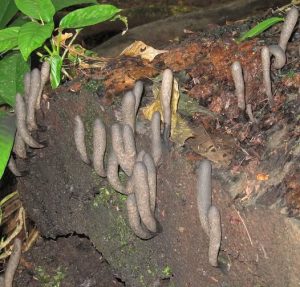Imagine being in the middle of a temperate forest. The ground is covered in layers of decomposing leaves, and the air smells like moss and old wood. You spot something black as you walk cautiously past a bunch of ancient tree stumps. It’s a clump of thick, finger-like creatures sticking up from the base of a rotting log. They look extremely real at first. Because they are twisted, blackened, and a little crooked, they resemble like rotting human fingers sticking out of the ground. Even the most experienced hiker would need a break.
This isn’t something that happened because of a terrible narrative; it’s a bizarre and fascinating thing that happens in nature. This is Xylaria polymorpha, which is better known as Dead Man’s Fingers.
This fungus is very much alive and quite genuine, even though it grows around death. The word might sound like something from a story. It belongs to the Xylariaceae family, which is made up of fungus that break down wood. Dead Man’s Fingers loves to grow on hardwood trees that are dead or dying, such beech, oak, sycamore, maple, or elm trees. It prefers to grow around old stumps, roots that are underground, and the base of rotting logs, mainly in shaded, wet regions where decomposition has already set in.

The parts of the fungus that grow above ground are the most intriguing, but what happens below the surface is considerably more significant. There are a lot of mycelium threads running through the wood underneath the forest floor. These threads operate quietly to break down cellulose and lignin, which are the tough parts that make wood strong. A chain of enzymes in Xylaria polymorpha breaks this substance down into simpler molecules that it can take in. It is like recycling the tree and putting its nutrients back into the ground. This process of breaking down is important for the ecology because it helps sustain the nutritional balance in forest ecosystems and lets new plants grow.
The black, finger-like objects we see are the mature fruiting bodies of the fungus, which are termed stromata. Stromata can be spherical, short, or slightly flat, and they can be anywhere from 3 to 10 cm tall. They usually come out in groups and look like they’re attempting to get out of the ground or wood. They could have a bluish-gray, powdery coating on them as they first start to grow. This creates a layer of asexual spores called conidia. As they age, this coating dissolves, and the structures turn dark brown or black, becoming harder and more like fingers in color and texture. As time goes on, the fungus’s exterior grows little holes called perithecia that look like pimples. This is where sexual spores (ascospores) are let off into the air.
Mushrooms generate spores on gills or pores, but Dead Man’s Fingers has a more complex manner of reproducing. There are several flask-shaped chambers inside the stromata where spores grow. These spores are released into the air when it’s warm and humid so they can find a new dead host to live on.
Xylaria polymorpha is found all across the Northern Hemisphere, but it is most prevalent in Europe, North America, and some parts of Asia. It’s not rare, but its pale color and close proximity to the ground make it easy to miss. You can observe it any time of year, but its fruiting bodies are most numerous in the spring and fall. Unlike many fungi that break down quickly, Dead Man’s Fingers can survive for months or even years. They gently break down timber and stand still in the woods like bony fingers.
People have been fascinated and scared by this fungus for a long time. Because it looks so bad, it has gotten a lot of nicknames in different cultures. Most of them have to do with death, rotting, or hands that aren’t attached to anything. Some folk traditions thought it was a sign or omen from the gods, especially if it was found near burial sites or old trees. People that adore mushrooms, snap images of forests, and post nature pictures with a Halloween theme have all come to enjoy it because it looks spooky.
Dead Man’s Fingers may look terrible, but it isn’t poisonous. But you can’t eat it either. The stromata are hard, bitter, and not good for cooking. It’s also hard to break them apart, like sticks or charcoal that have hardened. They are used in natural dyeing and research on fungal pigments from time to time, although not as much as brighter, more colorful fungi.
Scientists are interested in Xylaria polymorpha for more than just how it looks. Recent studies have explored its potential in biotechnology and medicine, given that some wood-decomposing fungi produce compounds with antibacterial or antioxidant properties. It isn’t a big deal in medical research yet, but its intricate biochemistry makes it an excellent candidate for more research into how fungi break things down and how things break down on their own.
This fungus is significant because it shows a bigger principle in nature: that life comes from death. It may look unusual, but it’s a good indicator that the forest is working: old trees are being broken down, and their energy and nutrients are going back into the ecosystem. The Dead Man’s Fingers fungus is a part of the cycle of life. It converts dead items into good soil for the next generation of plants, insects, and animals.
If you see what looks like a dead hand coming out of the ground the next time you go to the woods, don’t freak out. Instead, take a closer look. You may observe one of nature’s top recyclers at work, dressed like a ghost from a book.
Nature does have awful taste in clothes, after all.
